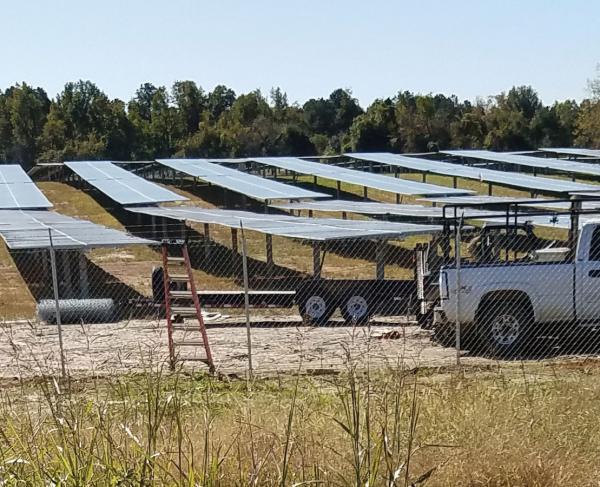Utility-Scale Solar Facility Development: Assessing Impact on Historic Battlefields and Related Resources
Recommended Policy Language for Virginia Localities
The American Battlefield Trust encourages Virginia localities to consider adopting the following policy language to assist in their evaluation of applications for utility-scale solar facilities and the impacts of such facilities on historic battlefields and related resources:
1. [County/City] seeks to ensure that the development of any utility-scale solar facility is consistent with — and furthers the goals identified in — the most current Comprehensive Plan. Furthermore, [County/City] desires to balance this land use with the various and valuable existing and planned land uses and resources throughout [County/City]. To this end, the following elements should be considered and studied with respect to each application for a utility-scale solar facility:
- Impacts to other economic activities should be carefully considered, including — but not limited to — whether the visual effects of the solar facility will diminish the experience of visitors to rural agricultural and historic properties and districts or discourage visitation to such properties or districts.
- The applicant shall provide information demonstrating the local economic benefits of the project or a cost/benefit analysis. The cost/benefit analysis shall consider potential impacts to heritage tourism and other economic activities associated with the historic and agricultural resources affected by, or within the viewshed of, the proposed facility.
- [County/City] desires to protect its historic landscapes, properties and related resources and sets forth the following guidelines accordingly:
- Certain property, because of its historic value, should be discouraged from this land use entirely.
- No facility shall be located on a property listed on, or eligible for listing on, the National Register of Historic Places, as designated by the State Historic Preservation Office, and/or the National Park Service.
- Lands located within federally-recognized historic battlefield boundaries as identified and maintained by the National Park Service’s American Battlefield Protection Program shall not be considered eligible for utility-scale solar development.
- [County/City] desires to protect its agricultural resources and will take into consideration the following guidelines accordingly:
- Size and scale of the proposed facility should be considered vis-à-vis any adverse impacts to surrounding viewsheds.
- No facility shall be located on lands designated as prime agricultural soils. Lands of lower agricultural value should be assessed based in part on classification of agricultural value, as listed by the State Land Evaluation and Advisory Council (SLEAC).
- To protect the integrity of agricultural soils, mass grading of sites shall be limited to the extent possible.
- Facilities adjacent to — or within the viewshed of — historic properties, agricultural or forestal districts, shall take into account and minimize the impact upon any such resources and districts.
- The applicant shall prepare a visual impact analysis to determine the level of visual impact the project imposes on adjacent properties.
- The applicant shall prepare a plan to minimize any negative visual impact to the greatest extent possible.
- Increased setbacks and buffering should be considered when an application is adjacent to such resources.
2. [County/City] desires to minimize impacts to adjacent properties and retain existing rural character through consideration of facility siting, adequate setbacks, and visual buffers.
- A minimum setback of two hundred fifty (250) feet shall be maintained from any above-ground equipment to the nearest property line. This area should include the requirement to maintain any existing vegetation and/or fencing that is in place and may require supplementary landscaping. These requirements shall not apply to any interior property lines.
- A landscaping plan shall be submitted and approved prior to Certificate of Occupancy to provide buffering and screening of adjacent properties. The following conditions shall govern the installation of landscaping in accordance with the approved plan:
- In areas where there is not at least one hundred fifty (150) feet of a native timber buffer remaining on the project parcel, a minimum of a double row of evergreens will be planted within any required setback and/or buffer area. All native timber buffers are subject to review and approval by the [County/City]. The use of native timber and natural screening is preferable. Such evergreens shall be planted, at a minimum, on fifteen (15) foot centers, with rows offset. The evergreens installed shall have an anticipated mature height of thirty (30) to forty (40) feet. The composition of this landscape buffer may be a mixture of native evergreens and/or deciduous trees as deemed appropriate by the [County/City]. These evergreens shall be planted during an appropriate time of year, subsequent to the completion of construction. (This requirement may be reduced or waived if agreed to, in writing, by the owner of the adjacent residence, including residences across a public right of way.) The composition and layout above is offered as a typical planting arrangement — however, the [County/City] reserves the right to require a different composition or layout pursuant to the specific circumstances of an individual project or application.
- Evergreen plantings shall have a minimum beginning planting height of six (6) feet. Any deciduous tree shall have a minimum caliper of two (2) to two and one-half (2.5) inches measured six (6) inches above final grade at the time of planting.
- The [County/City] reserves the right to impose conditions on the site plan approval which specify species of landscaping.
- All landscaping will be reviewed by the [County/City] following installation, at one year after completion, and as necessary after this to ensure the landscaping is being consistently maintained.
- The use of herbicides and pesticides shall be limited.
3. [County/City] desires to minimize the potential cumulative effects of numerous facilities located near, adjacent to or within an observable region or viewshed, as well as any impacts requiring expansion of existing utility infrastructure.
- The applicant must provide written comments from the relevant electric company regarding the capacity of existing transmission lines envisioned to receive the electricity generated from the utility-scale solar facility. Proof of application for interconnection to the existing electricity system is required.
- An application shall not be approved if located directly adjacent to or within five (5) miles of an existing or previously approved facility. The cumulative effects to an important five-mile viewshed related to designated historic properties — or a designated historic battlefield boundary within a region or sub-region — will be considered.
- The applicant shall address both mitigation of direct impacts as well as perceived cumulative impacts to the project and other past, planned or future utility-scale solar facilities within a given regional or spatial boundary.
- The applicant shall identify the geographic boundary of effects by identifying direct impacts (noting that impacts to some resources extend beyond property boundaries and limits of construction). Direct impacts should include but not be limited to an analysis of the impacts to the following resources: (i) prime agricultural soils, (ii) viewshed impacts as observed from key observation points, (iii) natural and cultural resources, and (iv) others as identified in preliminary review with [County/City] staff.
- The applicant shall identify trends likely to result in future and subsequent impacts to the resource and identify how past, current, and future trends for utility-scale solar facilities are likely to affect resources within the geographic boundary. The applicant shall confirm how this proposal contributes to or alters trends — including proximity of the project area to another existing or proposed utility-scale solar facility, based in part but not limited to those applications currently on record with the Virginia Department of Environmental Quality or State Corporation Commission at the time of application.
4. [County/City] desires to minimize impacts to adjacent properties and assets during construction — limiting disruption to surrounding property owners and economies by requiring responsible construction practices — as well as ensure the adequate decommissioning of the facility. Accordingly, applications for utility-scale solar facilities shall include:
- A plan to minimize noise, traffic, and other impacts related to or stemming from the construction and/or decommissioning of the facility.
- Mitigation of other identified direct and indirect impacts, including stormwater impacts, occurring during all stages of construction, general operation, and at the time of decommissioning shall be required.
- All facilities will be designed and oriented to minimize the reflection of light, with select colors and materials that blend well with the surrounding landscape character.
- Lighting shall be limited to the minimum necessary for safety during construction, operation, and decommissioning and shall comply with local zoning ordinances.
- A decommissioning plan (with mandated updates and [County/City] review every three (3) years) will be required to ensure:
- That real property will be returned to its original condition upon closure of the facility, or at the end of its useful life;
- That decommissioned equipment and panels are appropriately disposed of in an environmentally sound manner; and
- That the facility’s decommissioning shall be guaranteed by cash, commercial surety, letter of credit, performance bond or other means subject to the approval of the [County/City] Attorney and in accordance with adopted [County/City] policy. Final reporting of decommissioning activities, and [County/City] authorized acceptance of efforts at the conclusion of the decommissioning will be required before the release of any guarantee.











